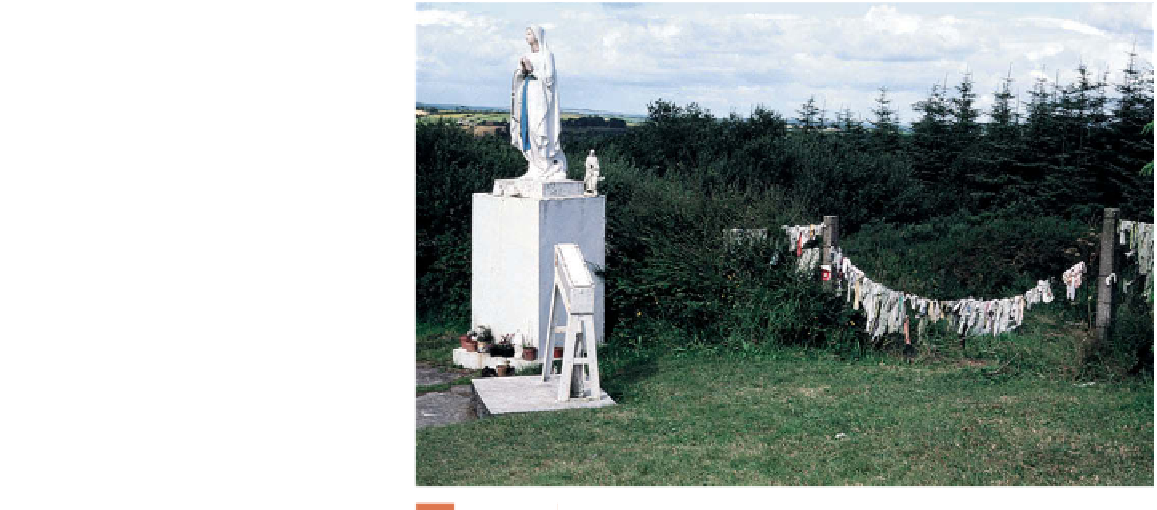Geography Reference
In-Depth Information
Guest
Field Note
Ardmore, Ireland
At St. Declan's Holy Well in Ireland, I found a
barbed wire fence substituting for the more
traditional thorn tree as a place to hang
scraps of clothing as offerings. This tradition,
which died out long ago in most parts of Con-
tinental Europe, was one of many aspects of
Irish pilgrimage that led me to speculate on
“Galway-to-the-Ganges” survival of very old
religious customs on the extreme margins of
an ancient Indo-European culture realm. My
subsequent fi eldwork focused on contem-
porary European pilgrimage, but my curios-
ity about the geographical extent of certain
ancient pilgrimage themes lingered. While
traveling in Asia, I found many similarities
among sacred sites across religions. Each reli-
gion has formation stories, explanations of how particular sites, whether Buddhist monasteries or Irish wells, were recog-
nized as sacred. Many of these stories have similar elements. And, in 1998, I traveled across Russia from the remote Kam-
chatka Peninsula to St. Petersburg. Imagine my surprise to fi nd the tradition of hanging rag offerings on trees alive and well
all the way across the Russian Far East and Siberia, at least as far as Olkon Island in Lake Baikal.
Credit: Mary Lee Nolan, Oregon State University
Figure 7.19
diffused to Ireland, the Catholic Church usurped many
of these features, infusing them with Christian meaning.
Nolan described the marriage of Celtic sacred sites and
Christian meaning:
cerns, and the act of designating certain sacred spaces
as public recreational or tourist areas. Geographer
Kari Forbes-Boyte studied Bear Butte, a site sacred
to members of the Lakota and Cheyenne people in
the northern Great Plains of the United States and a
site that became a state park in the 1960s. Bear Butte
is used today by both Lakota and Cheyenne people in
religious ceremonies and by tourists who seek access
to the recreational site. Nearby Devils Tower, which
is a National Monument, experiences the same pull
between religious use by American Indians and recre-
ational use by tourists.
Places such as Bear Butte and Devils Tower experi-
ence contention when one group sees the sites as sacred
and another group does not. In many parts of the world,
sacred sites are claimed as holy or signifi cant to adher-
ents of more than one religious faith. In India several
sites are considered sacred by Hindus, Buddhists, and
Jains. Specifi cally, Volture Peak in Rajgir in northeast-
ern India is holy to Buddhists because it is the site where
Buddha fi rst proclaimed the Heart Sutra, a very impor-
tant canon of Buddhism. Hindus and Jains also consider
the site holy because they consider Buddha to be a god or
prophet. Fortunately, this site has created little discord
among religious groups. Pilgrims of all faiths peacefully
The early Celtic Church was a unique institution, more
open to syncretism of old and new religious traditions
than was the case in many other parts of Europe. Old holy
places, often in remote areas, were “baptized” in the new
religion or given new meaning through their historical,
or more often legendary, association with Celtic saints.
Such places were characterized by sacred site features
such as heights, insularity, or the presence of holy water
sources, trees, or stones.
Nolan contrasted Irish sacred sites with those in conti-
nental Europe, where sacred sites were typically built in
urban, accessible areas. In continental Europe, Nolan
found that the “sacred” (bones of saints or images) was
typically brought to a place in order to infuse the place
with meaning.
In many societies, features in the physical geo-
graphic landscape remain sacred to religious groups.
Access to and use of physical geographic features are
constrained by private ownership, environmental con-
225










































